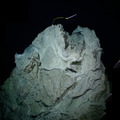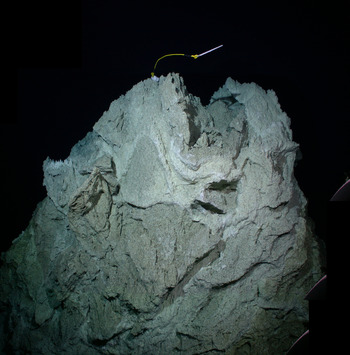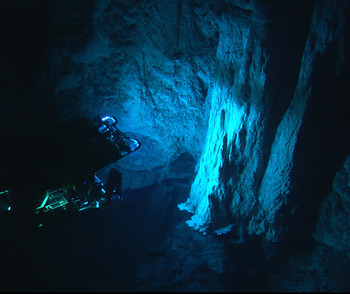2005 Lost City Expedition
R/V Brown and D/S Hercules
The primary mission during the 10-day Lost City 2005 Expedition was to conduct around-the-clock exploration of the Lost City Hydrothermal Field (LCHF) and to conduct the first test of Ocean Explorations operational model using telepresence. Research was conducted aboard the NOAA research vessel (R/V) Ronald H. Brown and utilized the Institute for Exploration's remotely operated vehicle (ROV) systems Argus and Hercules. The Lost City program together new technology that allowed shore-based scientists nearly 5000 miles away at the UW to conduct "sea-going" research in real-time via the underwater robotic systems and satellite transmissions. The ROVs were supported by a state-of-the-art shipboard control system and a ship-to-shore satellite telecommunication system that sent live video, audio, and scientific data to shore-based command centers. Through live transmission, this expedition brought never-before-seen views of this remarkable submarine ecosystem live to researchers, educators, and the public using the internet.
This expedition represents the primary component of a major educational outreach program -- a partnership between NOAA's Office of Ocean Exploration, the University of Washington, the University of Rhode Island, Immersion Presents, and the Jason Foundation for Education. Through real-time video, audio, and data transmissions, five live, daily educational broadcasts were viewed by audiences throughout the country.
Exploration with the ROVs Argus and Hercules primarily focused on the Lost City Hydrothermal Field (LCHF). However, the first dirve focused on the exploration of a 12 million year old site to to the west of Lost City that was geologically similar to the Atlantis Massif, where the LCHF is located. The crust in this region was once in the same position relative to the Mid-Atlantic Ridge as Atlantis Massif is now. Roughly at the same depth, it consists of the same rock types but also includes pillow basalts, in addition to gabbroic ± peridotite material. We had hoped to find an older Lost City Field, but with only one day of exploration, this did not occur.
The main objective of the cruise was to continue to explore and map the LCHF and to collect new samples and images from the extraordinary carbonate vents that make up the field. We obtained remarkable high-definition video and high-resolution digital still photographs that allowed us to to create photomosaics of the IMAX, Poseidon, and Nature Tower venting sites. The largest chimney within the field, Poseidon, stands 200 ft above the sea floor; many chimneys exceed 60-90 ft in height. The mosaics provide new insights into the geologic processes that have helped create the field, how the chimneys grow and evolve, and details about the vent animals that live more than 2000 ft beneath the ocean's surface at this site.
The manipulators on the ROV were used to collect a variety of carbonate and biological samples from the vent sites. These included samples of the macrofauna that populate the sites, samples of novel microbes that grow both on the outside and within the walls of the limestone chimneys, and fluid and gas samples from active vents. The carbonate samples allowed continued investigation into the age of the hydrothermal chimneys (Ludwig et al., 2010), showing that the field has been active for >100,000 years.




